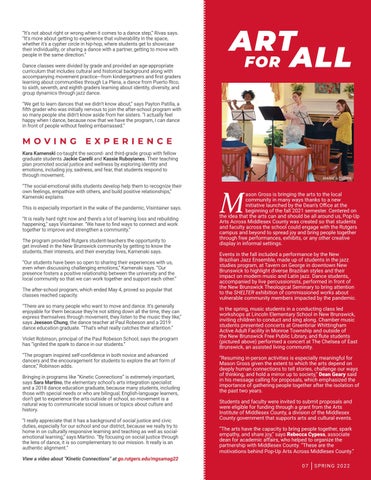“It’s not about right or wrong when it comes to a dance step,” Rivas says. “It’s more about getting to experience that vulnerability in the space, whether it’s a cypher circle in hip-hop, where students get to showcase their individuality, or sharing a dance with a partner, getting to move with people in the same direction.” Dance classes were divided by grade and provided an age-appropriate curriculum that includes cultural and historical background along with accompanying movement practice—from kindergartners and first graders learning about communities through La Plena, a dance from Puerto Rico, to sixth, seventh, and eighth graders learning about identity, diversity, and group dynamics through jazz dance.
ART FOR ALL
“We get to learn dances that we didn’t know about,” says Payton Patilla, a fifth grader who was initially nervous to join the after-school program with so many people she didn’t know aside from her sisters. “I actually feel happy when I dance, because now that we have the program, I can dance in front of people without feeling embarrassed.”
MOVING
EXPERIENCE
Kara Kamenski co-taught the second- and third-grade group with fellow graduate students Jackie Carelli and Kassie Ruboyianes. Their teaching plan promoted social justice and wellness by exploring identity and emotions, including joy, sadness, and fear, that students respond to through movement. “The social-emotional skills students develop help them to recognize their own feelings, empathize with others, and build positive relationships,” Kamenski explains. This is especially important in the wake of the pandemic, Visintainer says. “It is really hard right now and there’s a lot of learning loss and rebuilding happening,” says Visintainer. “We have to find ways to connect and work together to improve and strengthen a community.” The program provided Rutgers student-teachers the opportunity to get involved in the New Brunswick community by getting to know the students, their interests, and their everyday lives, Kamenski says. “Our students have been so open to sharing their experiences with us, even when discussing challenging emotions,” Kamenski says. “Our presence fosters a positive relationship between the university and the local community so that we can work together and support each other.” The after-school program, which ended May 4, proved so popular that classes reached capacity. “There are so many people who want to move and dance. It’s generally enjoyable for them because they’re not sitting down all the time, they can express themselves through movement, they listen to the music they like,” says Jeeseon Chung, the dance teacher at Paul Robeson and a 2019 dance education graduate. “That’s what really catches their attention.” Violet Robinson, principal of the Paul Robeson School, says the program has “ignited the spark to dance in our students.” “The program inspired self-confidence in both novice and advanced dancers and the encouragement for students to explore the art form of dance,” Robinson adds. Bringing in programs like “Kinetic Connections” is extremely important, says Sara Martino, the elementary school’s arts integration specialist and a 2018 dance education graduate, because many students, including those with special needs or who are bilingual, English-language learners, don’t get to experience the arts outside of school, so movement is a natural way to communicate social issues or topics about culture and history. “I really appreciate that it has a background of social justice and civic duties, especially for our school and our district, because we really try to home in on culturally responsive learning and teaching as well as socialemotional learning,” says Martino. “By focusing on social justice through the lens of dance, it is so complementary to our mission. It really is an authentic alignment.”
AMANDA BROWN
M
ason Gross is bringing the arts to the local community in many ways thanks to a new initiative launched by the Dean’s Office at the beginning of the fall 2021 semester. Centered on the idea that the arts can and should be all around us, Pop-Up Arts Across Middlesex County was created so that students and faculty across the school could engage with the Rutgers campus and beyond to spread joy and bring people together through free performances, exhibits, or any other creative display in informal settings. Events in the fall included a performance by the New Brazilian Jazz Ensemble, made up of students in the jazz studies program, at Tavern on George in downtown New Brunswick to highlight diverse Brazilian styles and their impact on modern music and Latin jazz. Dance students, accompanied by live percussionists, performed in front of the New Brunswick Theological Seminary to bring attention to the SHELTER exhibition of commissioned works about vulnerable community members impacted by the pandemic. In the spring, music students in a conducting class led workshops at Lincoln Elementary School in New Brunswick, inviting children to conduct and sing along. Chamber music students presented concerts at Greenbriar Whittingham Active Adult Facility in Monroe Township and outside of the New Brunswick Free Public Library, and flute students (pictured above) performed a concert at The Chelsea of East Brunswick, an assisted living community. “Resuming in-person activities is especially meaningful for Mason Gross given the extent to which the arts depend on deeply human connections to tell stories, challenge our ways of thinking, and hold a mirror up to society,” Dean Geary said in his message calling for proposals, which emphasized the importance of gathering people together after the isolation of the past two years. Students and faculty were invited to submit proposals and were eligible for funding through a grant from the Arts Institute of Middlesex County, a division of the Middlesex County government that supports arts and cultural events. “The arts have the capacity to bring people together, spark empathy, and share joy,” says Rebecca Cypess, associate dean for academic affairs, who helped to organize the partnership with Middlesex County. “These are the motivations behind Pop-Up Arts Across Middlesex County.”
View a video about “Kinetic Connections” at go.rutgers.edu/mgsamag22 07
SPRING 2022












